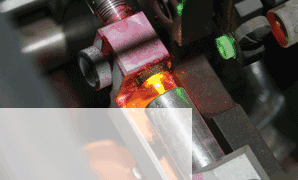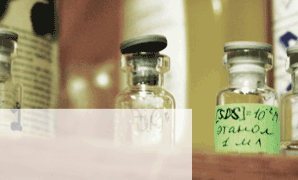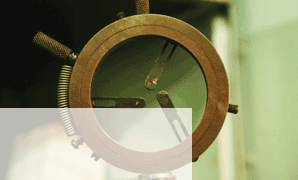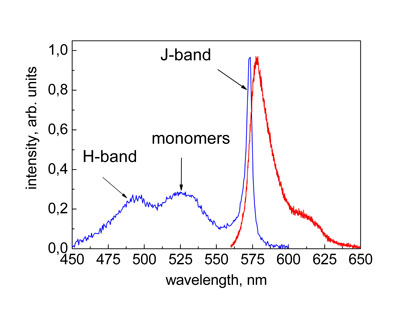 |
Home  Team Team  Contact us Contact us |
| About us | Our activity | Highlights | Publications | Gallery | New events |
| RE-doped nanocrystals | J-aggregates | Cell marking | Inorganic synthesis | Organic synthesis |
 |
 |
 |
Luminescent molecular nanoclusters – J-aggregates
J-aggregates are ordered luminescent nano-assemblies of non-covalently coupled luminophores such as cyanines, porphyrines and some other dyes. They were discovered in 1930th independently by E. Jelley (in 1936) and G. Scheibe (in 1937) in a concentrated water solution of cyanine dye PIC by appearance of new very narrow and intense absorption band (called J-band) bathochromically shifted relative the monomeric band, and near resonant luminescence band.
Typical absorption (blue curve) and luminescence (red curve) spectra of J-aggregates:
Since their discovery, J-aggregates ("Jelley" aggregates, rarely called Scheibe-aggregates) have been of fundamental interest due to their intermediate position between dissolved molecules and structurally ordered crystals. Spectral properties of the novel type of dye aggregates were found to be explained within Frenkel’s exciton model and now it is the main concept. Optical characteristics of J-aggregates are governed by the exciton delocalization length, which is usually equal to up to tens monomers, rather than the physical length of aggregates. Due to excitonic nature of electronic excitations, J-aggregates reveal a number of unique spectral properties such as very narrow for organic molecules spectral lines (tens of cm–1 at liquid helium temperatures), large extinction coefficients (hundreds of thousands of cm–1?M–1), giant third-order optical nonlinearities up to 10–5 esu and so on.
Beside the change of the exciton delocalization length, there is another way to affect the J-aggregate spectral properties. That is the change of molecular arrangement in the J-aggregate chain. If molecular arrangement is changed from "side-by-side" or "head-to-tail" (angle < 54.7°, see Figure a below), which is typical for J-aggregates, to "face-to-face" or "head-to-head" (angle > 54.7°, see Figure b below), excitonic absorption band shifts hypsochromically with respect to the monomers one. Such aggregates are called H-aggregates (aggregates with hypsochromic band, H-band) and they are typically non-luminescent. In some cases both J- and H-band could be observed in the absorption spectrum. This case corresponds to the "herringbone" type arrangement of dye molecules with two molecules per unit cell (see Figure c below). H- and J-bands are upper- and lower Davydov components of the exciton band.
Schematic arrangements of molecules, corresponding to: a) J-aggregates, b) H-aggregates, c) "herringbone" J-aggregates with both H- and J-bands.Our interests in J-aggregates:
• exciton transport read more
• localization of excitons (including self-trapping) read more
• control of luminescent properties read more
• hybrid organic-inorganic materials based on J-aggregates
• biomedical application read moreOur J-aggregating dyes and preparation methods. read more
Contacts:
Group leader – Alexander Sorokin, PhD, Chief of Lab
E-mail: sorokin@isma.kharkov.ua
Skype: j-guys
Phone: +38 057 341-03-09
to the top

